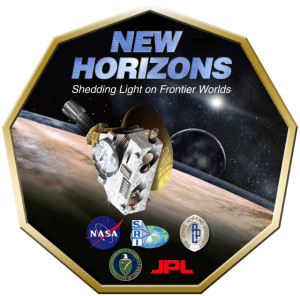 NASA’s New Horizons spacecraft which has been travelling towards Pluto since its launch in 2006 has now entered the flyby activity phase of the mission. While closest approach will not be until July 14th the spacecraft will be performing plenty of different activities before then, as it races towards the dwarf planet.
NASA’s New Horizons spacecraft which has been travelling towards Pluto since its launch in 2006 has now entered the flyby activity phase of the mission. While closest approach will not be until July 14th the spacecraft will be performing plenty of different activities before then, as it races towards the dwarf planet.
Due to the extreme distance of the spacecraft it takes four hours for a signal to arrive back on Earth and will take almost a year for all the data captured to be returned.
The spacecraft carries seven scientific instruments. Total mass is 31 kg (68 lb) and rated power is 21 watts (though not all instruments operate simultaneously).
Fundamental physics-Pioneer Anomaly
New Horizons may be used to test the Pioneer Anomaly issue as it has an Ultrastable Oscillator subsystem.
Long Range Reconnaissance Imager (LORRI)
LORRI is a long focal length imager designed for high resolution and responsivity at visible wavelengths. The instrument is equipped with a high-resolution 1024×1024 monochromatic CCD imager with a 208.3 mm (8.20 in) aperture giving a resolution of 5 μrad (~1 asec). The CCD is chilled far below freezing by a passive radiator on the antisolar face of the spacecraft. This temperature differential requires insulation, and isolation from the rest of the structure. The Ritchey–Chretien mirrors and metering structure are made of silicon carbide, to boost stiffness, reduce weight, and prevent warping at low temperatures. The optical elements sit in a composite light shield, and mount with titanium and fiberglass for thermal isolation. Overall mass is 8.6 kg (19 lb), with the Optical tube assembly (OTA) weighing about 5.6 kg (12 lb), for one of the largest silicon-carbide telescopes flown at the time (now superseded by Herschel).

Pluto Exploration Remote Sensing Investigation (PERSI)
This consists of two instruments: The Ralph telescope, 6 cm (2.4 in) in aperture, with two separate channels: a visible-light CCD imager (MVIC- Multispectral Visible Imaging Camera) with broadband and color channels, and a near-infrared imaging spectrometer, LEISA (Linear Etalon Imaging Spectral Array). LEISA is derived from a similar instrument on the EO-1 mission. The second instrument is an ultraviolet imaging spectrometer, Alice. Alice resolves 1,024 wavelength bands in the far and extreme ultraviolet (from 50–180 nm), over 32 view fields. Its goal is to view the atmospheric makeup of Pluto. This Alice is derived from an Alice on the Rosetta mission. Ralph, designed afterwards, was named after Alice’s husband on The Honeymooners. Ralph and Alice are names, not acronyms.
Plasma and high-energy particle spectrometer suite (PAM)
PAM consists of two instruments: SWAP (Solar Wind At Pluto), a toroidal electrostatic analyzer and retarding potential analyzer, and PEPSSI (Pluto Energetic Particle Spectrometer Science Investigation), a time of flight ion and electron sensor. SWAP measures particles of up to 6.5 keV, PEPSSI goes up to 1 MeV. Because of the tenuous solar wind at Pluto’s distance, the SWAP instrument has the largest aperture of any such instrument ever flown.
Radio Science Experiment (REX)
REX will use an ultrastable crystal oscillator (essentially a calibrated crystal in a miniature oven) and some additional electronics to conduct radio science investigations using the communications channels. These are small enough to fit on a single card. Since there are two redundant communications subsystems, there are two, identical REX circuit boards. There is an outstanding request for a series of Geophysical Telegrams to be issued so that the REX can avoid failures and obtain more scientifically useful information.
Built by students at the University of Colorado at Boulder, the Student Dust Counter will operate continuously through the trajectory to make dust measurements. It consists of a detector panel, about 460 mm × 300 mm (18 in × 12 in), mounted on the antisolar face of the spacecraft (the ram direction), and an electronics box within the spacecraft. The detector contains fourteen polyvinylidene difluoride (PVDF) panels, twelve science and two reference, which generate voltage when impacted. Effective collecting area is 0.125 m2 (1.35 sq ft). No dust counter has operated past the orbit of Uranus; models of dust in the outer Solar System, especially the Kuiper belt, are speculative. VBSDC is always turned on measuring the masses of the interplanetary and interstellar dust particles (in the range of nano- and picograms) as they collide with the PVDF panels mounted on the New Horizons spacecraft. The measured data is expected to greatly contribute to the understanding of the dust spectra of the Solar System. The dust spectra can then be compared with those observed via telescope of other stars, giving new clues as to where earthlike planets can be found in our universe. The dust counter is named for Venetia Burney, who first suggested the name “Pluto” at the age of 11. A thirteen-minute short film about VBSDC garnered an Emmy award for student achievement in 2006.
The scientific instrument information was taken from Wikipedia
Leave a Reply